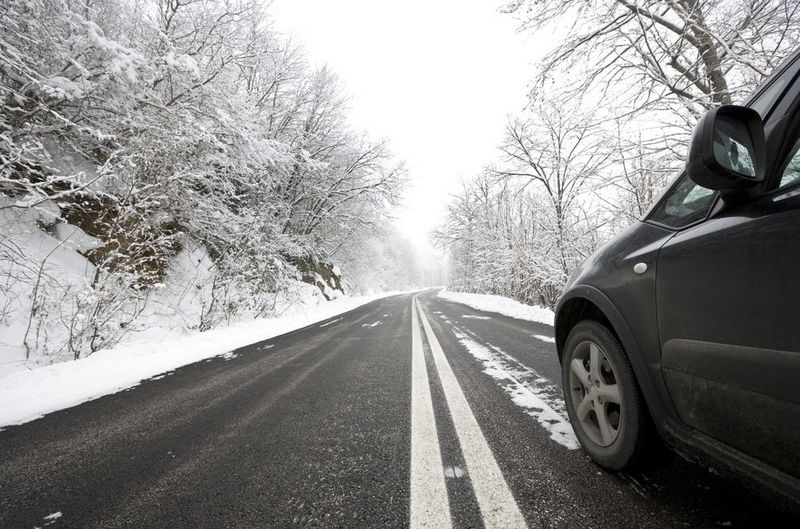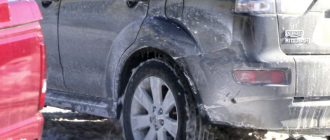
How To Prepare For Winter Driving
With winter just around the corner, it’s important to make sure you’re prepared for the challenges that come with driving in snowy and icy conditions. Snowy and icy roads can be treacherous, but by following a few simple tips, you can ensure your safety and the safety of others on the road.
One of the most important things to do before hitting the road in winter is to make sure your car is properly maintained. Check your tires to ensure they have adequate tread depth and are in good condition. Snow tires or chains may be necessary if you live in an area with heavy snowfall. It’s also important to check your brakes, wipers, and defroster to ensure they are functioning properly.
When driving in snowy or icy conditions, it’s important to adjust your driving techniques accordingly. Slow down and increase your following distance to allow for extra time to stop. Use caution when accelerating and braking, as it’s easy to lose traction on slippery surfaces. If you do start to skid, remember to steer into the skid and gently apply the brakes.
Another key aspect of winter driving safety is being prepared for emergencies. Keep an emergency kit in your car that includes items such as a flashlight, blankets, a shovel, and jumper cables. It’s also a good idea to keep extra snacks and water in case you become stranded for an extended period of time.
Winter driving can be challenging, but by taking the time to prepare and follow these tips, you can help ensure that you and your passengers arrive at your destination safely. Remember to stay alert, adjust your driving techniques, and always prioritize safety when driving in winter conditions.
Tips for Safe Winter Driving
Winter driving conditions can be extremely challenging and dangerous. It is important to take the necessary precautions to ensure your safety and the safety of others on the road. Here are some tips to help you prepare for driving in winter conditions:
- Prepare your car: Before the winter season arrives, make sure to check your car’s battery, tires, brakes, and wipers. It is also a good idea to carry an emergency kit in your car, which should include items like a flashlight, extra batteries, a blanket, a shovel, and extra food and water.
- Check the weather conditions: Before heading out, check the weather forecast for any upcoming snowstorms or icy conditions. If the weather is severe, it might be best to stay home or delay your trip until the roads are clear.
- Drive slowly and cautiously: Reduce your speed and increase your following distance when driving in winter conditions. This will give you more time to react to any hazards on the road, such as black ice or slippery patches.
- Avoid sudden maneuvers: When driving on snow or ice, avoid sudden acceleration, braking, or turning. These actions can cause your car to lose traction and skid. Instead, make smooth and gradual movements.
- Use your headlights: Visibility is often reduced in winter weather, so make sure to turn on your headlights, even during the day. This will not only improve your visibility but also make your car more visible to other drivers.
- Be cautious on bridges and overpasses: These areas tend to freeze before the rest of the road, so approach them with extra caution. Slow down and maintain a steady speed while crossing them.
- Watch out for black ice: Black ice is a thin, transparent layer of ice that often forms on the road, making it extremely slippery. Be on the lookout for shiny, wet-looking spots on the road and reduce your speed when you encounter them.
- Keep a safe distance from snowplows: Snowplows are necessary for clearing the roads, but they can also create hazards. Stay at least three car lengths behind a snowplow and avoid passing them unless it is absolutely necessary.
- Stay informed: Listen to the radio or check the local news for any updates on road conditions or closures. It is always better to be aware of any potential dangers on the road before you start your journey.
By following these tips and exercising caution, you can help ensure your safety and the safety of others while driving in winter conditions. Remember, it is always better to be overprepared than underprepared when it comes to winter driving.
Preparing Your Vehicle for Winter
Winter can bring challenging driving conditions, including snow, ice, and low visibility. It is important to prepare your car for these conditions to ensure your safety on the road. Here are some tips to help you get your vehicle ready for winter:
- Get a winter maintenance check: Schedule a check-up with a certified mechanic to ensure that your car is in good condition for winter driving. They will check the battery, tires, brakes, and other essential components to make sure everything is working properly.
- Check your tires: Make sure your tires are in good condition and properly inflated. Consider switching to winter tires, which provide better traction in snowy and icy conditions.
- Top up your fluids: Ensure that your car has enough antifreeze to prevent freezing in cold temperatures. Check the levels of other fluids such as oil, windshield washer fluid, and brake fluid as well.
- Replace your wiper blades: Replace old or worn-out wiper blades with new ones. Good visibility is crucial in winter conditions, and new blades will help keep your windshield clear from snow and ice.
- Stock up your emergency kit: Prepare an emergency kit for your car that includes items such as a flashlight, extra blankets, food, water, a first aid kit, and a shovel. This will come in handy if you get stranded in bad weather.
- Test your lights: Check that all your lights are functioning properly, including headlights, brake lights, and turn signals. Proper lighting is essential for both your visibility and the visibility of other drivers.
- Keep your gas tank full: Try to keep your gas tank at least half full during the winter months. This not only prevents fuel lines from freezing but also ensures that you have enough fuel if you get stuck or stranded.
By following these tips, you can prepare your car for winter driving and help ensure your safety on the snowy and icy roads. Remember to drive cautiously and adjust your speed according to the road conditions. Stay safe!
Choosing the Right Tires for Snowy Roads
When it comes to winter driving, having the right tires on your car can make all the difference. Snow and ice can create slippery conditions that require special tires for optimal safety. Here are some tips to help you choose the right tires for snowy roads:
- Consider winter tires: Winter tires, also known as snow tires or cold weather tires, are specifically designed for driving in snowy and icy conditions. They are made with a special rubber compound that stays flexible even in freezing temperatures, providing better traction on snowy roads.
- Look for the 3PMSF symbol: When shopping for winter tires, look for the Three Peak Mountain Snowflake (3PMSF) symbol on the sidewall. This symbol indicates that the tire has met specific snow traction performance requirements and is suitable for severe snow conditions.
- Choose the right size: It’s important to choose winter tires that are the correct size for your car. Refer to your car’s user manual or consult a tire professional to find the right tire size for your vehicle.
- Consider studless tires: Studless winter tires are a popular option for snowy roads. They use advanced tread designs and soft rubber compounds to provide excellent traction on snow and ice without the use of metal studs. Studless tires are also quieter and offer better handling on dry pavement.
- Check the tire pressure: Proper tire pressure is crucial for optimal performance and safety. Make sure to check the tire pressure regularly and inflate the tires to the recommended levels listed in your car’s user manual.
Remember, having the right tires can significantly improve your car’s traction and handling on snowy roads. Don’t take any chances when it comes to winter driving – be prepared and choose the right tires for the conditions!
Checking Your Battery and Fluids
In winter conditions, it is important to make sure your car is properly prepared for driving in snow and ice. One key aspect of this preparation is checking your car’s battery and fluids.
Extreme cold temperatures can be tough on your car’s battery. To ensure your battery is in good working condition, it is a good idea to have it tested before winter arrives. A weak battery may not have enough power to start your car in cold weather, leaving you stranded. If your battery is more than three years old, it may be time to replace it.
In addition to your battery, it is also important to check your car’s fluids. Cold weather can cause fluids to thicken, which can make it harder for your car to start or function properly. Make sure to check your car’s oil, coolant, transmission fluid, and windshield washer fluid. It is recommended to use winter-grade versions of these fluids that are designed to withstand colder temperatures.
Here are some tips for checking your battery and fluids:
- Inspect your battery for any signs of corrosion or damage. Clean any corrosion off the terminals.
- If your battery is more than three years old, consider having it tested or replaced.
- Check your car’s oil level and make sure it is at the proper level. Consider switching to a winter-grade oil if necessary.
- Check the coolant level and make sure it is at the proper concentration. If necessary, top off the coolant or have it changed if it is old or dirty.
- Check the transmission fluid level and condition. Top off the fluid if necessary or have it changed if it is due.
- Check the windshield washer fluid level and make sure it is filled with a winter-specific fluid that is rated for below-freezing temperatures.
By regularly checking your car’s battery and fluids, you can help ensure its safety and reliability while driving in winter conditions.
Equipping Your Vehicle with Winter Supplies
Winter driving can be challenging due to the presence of snow and ice on the roads. To ensure your safety and preparedness, it is important to equip your car with the right supplies. Here are some tips to help you prepare:
- Snow shovel: Keep a snow shovel in your car to clear the snow around your vehicle if it gets stuck.
- Ice scraper: An ice scraper will help you remove ice from your car’s windows and windshield, improving visibility.
- Traction aids: Keep traction aids like sand, cat litter, or traction mats in your car. These can help provide traction if your car gets stuck on icy or snowy roads.
- Snow brush: A snow brush with a scraper will help you remove snow from your car’s roof, hood, and other surfaces.
- Extra windshield washer fluid: Make sure to refill your windshield washer fluid with a winter formula that does not freeze in low temperatures.
- Emergency kit: Prepare an emergency kit that includes items like blankets, a flashlight, extra batteries, a first aid kit, and non-perishable food and water. This kit will help you stay safe in case of unexpected incidents or long delays.
- Tire chains: Consider getting tire chains for your car’s tires. These can provide extra traction in extremely icy or snowy conditions.
It is important to regularly check the condition of your vehicle and ensure that the brakes, tires, lights, and other important components are in good working order. Additionally, make sure to adjust your driving habits to the road conditions by maintaining a safe distance from other vehicles, reducing your speed, and avoiding sudden maneuvers.
Ensuring Proper Visibility
In order to drive safely in winter conditions, it is crucial to ensure proper visibility. Limited visibility due to snow, ice, or fog can be extremely dangerous, so here are some tips to help you prepare:
- Clear snow and ice from all windows, mirrors, and lights on your car before driving.
- Top up your windshield washer fluid and use a formulation that is designed to work in freezing temperatures.
- Replace worn wiper blades to ensure they effectively remove snow and ice from your windshield.
- Adjust your side mirrors to minimize blind spots and maximize your field of view.
- Keep your headlights on at all times to increase your visibility to other drivers.
- Use your defroster and demister to clear fogged-up windows.
- Clean your headlights regularly, as they can become dirty or covered in road salt, reducing their effectiveness.
- Consider using winter-specific windshield wipers that are designed to handle heavy snow and ice buildup.
- Carry an ice scraper and a snow brush in your car to help clear away any buildup during your journey.
By following these tips, you will be better prepared to tackle winter driving conditions and ensure your safety on the road.
Driving Techniques for Snowy Conditions
Driving in snowy conditions can be challenging and requires special attention to ensure your safety and the safety of others on the road. Here are some important driving techniques to help you navigate snowy roads:
- Reduce your speed: Snowy roads are slippery, so it’s crucial to slow down and adjust your speed to match the road conditions. This will give you better control over your car.
- Keep a safe distance: Increase the distance between your car and the one ahead of you. This will allow for more time to react and brake if necessary, preventing accidents.
- Brake and accelerate gently: Apply the brakes and accelerator slowly, as abrupt movements can cause your car to skid on ice or snow. Gradual actions will help maintain traction.
- Steer smoothly: When turning or changing lanes, make sure to steer smoothly and avoid sudden jerks of the steering wheel. This will help you maintain control of the car.
- Avoid sudden stops: If possible, try to avoid sudden stops. It can be difficult to stop quickly on snowy roads, so maintaining a steady and consistent pace is ideal.
- Use low beams: Due to reduced visibility, it’s recommended to use low beam headlights while driving in the snow. High beams can reflect off the snow and impair your vision.
- Be cautious on bridges and overpasses: These areas tend to freeze faster than regular roads, so exercise additional caution when crossing them.
- Prepare your car: Before driving in snowy conditions, make sure your car is properly prepared. This may include checking the tire pressure, ensuring the windshield wipers are functioning, and having a snowbrush and ice scraper on hand.
Remember, safety should always be your top priority when driving in winter weather. By following these driving techniques and staying alert, you can help prevent accidents and arrive at your destination safely.
Maintaining a Safe Distance
When driving in winter conditions, maintaining a safe distance between your car and the vehicles around you is crucial. Snow and ice on the roads can significantly impact your ability to stop quickly, so it’s important to allow for extra space between you and the car in front of you.
Here are some tips to help you maintain a safe distance:
- Keep a 3 to 4-second gap: Increase the distance between your car and the vehicle in front of you to at least 3 to 4 seconds. This will give you enough time to react and stop safely if the car ahead suddenly stops or encounters any hazards.
- Adjust for adverse conditions: In snowy or icy conditions, it’s recommended to double the usual following distance. This will give you more time to stop or maneuver to avoid a collision.
- Watch for tailgaters: If you notice a car following too closely behind you, try to change lanes and allow them to pass. Having a tailgater can increase the risk of a rear-end collision, especially in winter driving conditions where stopping distances are longer.
- Stay attentive and focused: Avoid distractions, such as using your phone or eating while driving. Stay focused on the road ahead and be prepared for any sudden changes in traffic or road conditions.
By maintaining a safe distance, you can give yourself the necessary time and space to react in case of any unexpected situations on the road. Remember, the key to safe winter driving is being prepared and cautious.
Managing Skids and Slides
When driving in winter conditions, it is essential to know how to properly manage skids and slides to ensure your safety on the snowy and icy roads. Here are some helpful tips to help you prepare and react in case of skidding or sliding:
- Stay calm: One of the most important things to remember when skidding or sliding on snow or ice is to stay calm. Panicking can lead to overcorrecting and worsening the situation.
- Steer into the skid: If your car starts to skid, steer into the skid in the direction you want the front of the car to go. This technique can help you regain control of the vehicle.
- Release the brakes: If you start to slide when applying the brakes, release them immediately. This will allow your tires to regain traction and help you regain control of the car.
- Accelerate gradually: When starting from a stop or driving uphill on icy or snowy roads, apply gentle pressure to the accelerator. Avoid sudden bursts of acceleration that can cause your wheels to spin and lose traction.
- Keep a safe distance: Maintain a safe following distance from the car in front of you to give yourself enough time to react and avoid abrupt maneuvers that can result in skidding or sliding.
- Use winter tires: Installing winter tires can greatly improve your car’s traction on snowy and icy roads. They are specifically designed to provide better grip and control in winter conditions.
In conclusion, managing skids and slides in winter conditions is crucial for your safety. By staying calm, steering into skids, releasing the brakes, accelerating gradually, maintaining a safe distance, and using winter tires, you can reduce the risk of skidding or sliding and ensure a safer winter driving experience.
Using Anti-lock Brakes Correctly
In winter, when roads are covered in snow and ice, it’s crucial to understand how to use your car’s anti-lock brakes (ABS) correctly. ABS is a safety feature that helps prevent the wheels from locking up when you apply the brakes, making it easier to maintain control of your vehicle in slippery conditions.
Here are some tips to help you utilize your car’s ABS effectively:
- Do not pump the brakes: Unlike conventional brakes, ABS functions by automatically pumping the brakes for you, so there’s no need to manually pump them. Maintain firm pressure on the brake pedal, and let the ABS do the work.
- Keep your foot on the brake pedal: It’s important to keep your foot firmly on the brake pedal until your vehicle comes to a complete stop. This allows the ABS to continue modulating the braking pressure and prevents the wheels from locking up.
- Steer in the direction you want to go: If you need to steer while braking with ABS engaged, always steer in the direction you want to go. ABS helps you maintain control, so focus on steering safely to avoid any obstacles.
Properly using your car’s ABS can significantly improve your winter driving safety. Remember to always prepare your car for winter conditions and adjust your driving to suit the road conditions. Stay safe on the snow-covered roads!
Using Caution on Bridges and Overpasses
When it comes to winter driving, bridges and overpasses require extra caution and preparation. These elevated structures can become especially treacherous in snowy and icy conditions, posing a significant risk to your safety.
To ensure a safe drive, it’s crucial to prepare yourself and your vehicle for the challenges these winter conditions bring. Here are some essential tips to keep in mind:
- Stay Informed: Before heading out, check the latest weather forecast and road conditions in your area. Pay close attention to any warnings or advisories concerning bridges and overpasses.
- Reduce Speed: Drive at a slower speed when approaching and crossing bridges or overpasses. The surfaces of these structures cool down faster than regular roadways, making them more prone to ice formation.
- Keep Distance: Maintain a safe distance between your vehicle and others, especially when driving over bridges or overpasses. Increased braking distance is required on slippery surfaces.
- Use Caution on Entrances and Exits: Exercise extra caution when entering or exiting a bridge or overpass. These areas are often treated with anti-icing materials, which can be slippery.
- Watch for Black Ice: Be on the lookout for black ice, a thin, transparent layer of ice that is difficult to spot but extremely dangerous. Bridges and overpasses are notorious for black ice formation.
- Prepare for Limited Traction: Bridges and overpasses can have reduced traction due to their elevated design. Be prepared for less grip and avoid sudden movements, acceleration, or braking that can cause skidding.
By following these tips and being mindful of the unique challenges bridges and overpasses present in winter driving conditions, you can enhance your safety and the safety of others on the road. Remember, it’s always better to be cautious and prepared than to encounter avoidable risks when driving in snowy and icy conditions.
Knowing How to Handle Black Ice
When it comes to winter driving, one of the biggest challenges is navigating slippery road conditions caused by snow and ice. Black ice, also known as clear ice, is a particularly dangerous hazard that every driver should know how to handle. Here are some tips to help you stay safe when encountering black ice:
1. Stay alert and be aware of your surroundings
Black ice can be difficult to spot, as it blends in with the road surface. Pay close attention to the temperature, especially when it is near or below freezing, as this is when black ice is most likely to form. Be extra cautious on bridges, overpasses, and shaded areas, as these tend to freeze first.
2. Slow down and maintain a safe distance
Reduce your speed when driving on icy roads to allow yourself more time to react. Keep a greater distance between your car and the vehicle in front of you, as it will take longer to stop on slippery surfaces. Remember that it takes longer to brake on ice, so avoid sudden or erratic movements.
3. Avoid sudden braking or acceleration
When driving over black ice, it’s crucial to remain calm and avoid sudden changes in speed. Be gentle with the accelerator and brakes to maintain traction. If you start to slide, ease off the gas and steer in the direction you want the front of your car to go.
4. Don’t use cruise control
Using cruise control on icy roads is dangerous, as it can cause your car to maintain constant speed when you need to slow down or stop suddenly. Keep full control of your vehicle at all times, especially in slippery conditions.
5. Equip your car for winter conditions
Being prepared is key to safe winter driving. Make sure your tires are properly inflated and have adequate tread depth to maintain good traction. Consider using winter tires or tire chains for added grip on icy roads. Keep your windshield, windows, and lights clean and free of snow or ice to maximize visibility.
Remember, encountering black ice while driving can be extremely hazardous, but being aware of these tips can help you handle the situation safely. Always prioritize safety on the road and take necessary precautions to prepare yourself and your car for winter conditions.
Preparing for Emergency Situations
When driving in winter conditions, it is important to be prepared for emergency situations that may arise. Here are some tips to help you stay safe:
- Keep an emergency kit in your car: Your kit should include items such as a flashlight, extra batteries, a first aid kit, a blanket, a shovel, and non-perishable snacks. These items can be crucial if you find yourself stranded in the snow.
- Check your car before winter: Before the winter season begins, make sure your car is in good working condition. Check your tires for proper tread depth and inflation, ensure your brakes are working properly, and test your battery. It is also a good idea to have your car serviced to make sure everything is in proper working order.
- Plan your route: Before heading out on the road in wintery conditions, check the weather forecast and road conditions. Plan your route accordingly to avoid any dangerous areas. It is also a good idea to let someone know your destination and anticipated arrival time.
- Drive slowly and cautiously: When driving in snow or icy conditions, it is important to adjust your driving habits. Drive at a slower speed and increase your following distance to allow for more time to react to any potential hazards. Be cautious when braking, accelerating, and turning as these actions can be more difficult on slippery surfaces.
- Stay informed: Stay up to date on weather conditions and any road closures or advisories. Listen to the radio or check online for any updates before and during your trip.
- Carry a cell phone: In case of an emergency, it is important to have a means of communication. Always carry a fully charged cell phone with you when driving in wintery conditions.
- Know how to handle an emergency: Educate yourself on how to handle emergency situations such as a car breakdown or getting stuck in the snow. Knowing what to do can help alleviate stress and keep you safe until help arrives.
- Practice winter driving techniques: Take the time to practice winter driving techniques such as braking and steering on icy surfaces. This can help you become more comfortable and confident in your ability to drive in snowy conditions.
By following these tips and being prepared, you can help ensure your safety while driving in winter conditions. Remember to always prioritize your safety and the safety of others on the road.
Tips for Driving in Snowstorms
Winter driving can be challenging, especially when you have to deal with snowstorms. Snowstorms can create dangerous conditions on the roads, with the potential for ice and reduced visibility. To ensure your safety and the safety of others, it’s important to be prepared and follow these tips:
- Prepare your car: Before driving in a snowstorm, make sure your car is in good condition. Check your tires, brakes, windshield wipers, and lights. It’s also a good idea to have an emergency kit in your car with essentials like a shovel, ice scraper, blankets, and non-perishable food.
- Check the weather conditions: Stay updated on the weather conditions and any travel advisories. If possible, avoid driving in severe snowstorms or blizzard-like conditions.
- Drive slowly and cautiously: Reduce your speed and increase your following distance to allow for extra stopping time. Snowy roads can be slippery, so it’s important to drive at a safe and controlled speed.
- Keep a firm grip on the steering wheel: Maintain a firm grip on the steering wheel to have better control over your car. Be prepared for sudden gusts of wind, which can make steering more difficult.
- Use your headlights: Keep your headlights on to improve your visibility and make it easier for other drivers to see you. Use low beams, as high beams can reflect off the snow and impair visibility.
- Avoid sudden maneuvers: Avoid abrupt acceleration, braking, or turning, as these maneuvers can cause your car to slide on slippery roads. Gradual and smooth movements are key to maintaining control of your vehicle.
- Watch out for black ice: Black ice is a thin, transparent layer of ice that can form on the road surface. Be cautious when driving over bridges, overpasses, and shady areas, as these are common places where black ice can form.
- Stay informed and be patient: Listen to local news and radio for updates on road conditions and closures. If conditions are too severe, consider staying off the roads until they improve.
In conclusion, driving in snowstorms requires extra caution and preparation. By following these tips, you can navigate through the winter weather safely and arrive at your destination without any issues.
Understanding Frostbite and Hypothermia
When the snow falls and the temperatures drop, it’s important to be prepared for the harsh winter conditions. Not only should you take precautions when driving in icy or snowy conditions, but you should also be aware of the dangers of frostbite and hypothermia. Understanding these conditions and knowing how to prevent them can help keep you safe during the winter months.
What is Frostbite?
Frostbite occurs when exposure to cold temperatures causes freezing of the skin and underlying tissues. This most commonly affects extremities such as the fingers, toes, nose, and ears, as they are more susceptible to cold. Frostbite can cause tissue damage and, in severe cases, can lead to amputation.
Signs and Symptoms of Frostbite
- Loss of feeling or numbness in the affected area
- Skin that appears waxy, pale, or discolored
- Hard or frozen skin
- Blisters or ulcers
It’s important to recognize the signs of frostbite and seek medical attention immediately if you suspect that you or someone else may be experiencing this condition.
Preventing Frostbite
- Dress in warm layers and ensure that all body parts are covered, especially the extremities.
- Wear mittens instead of gloves to help keep your hands warmer.
- Avoid tight clothing or shoes that may restrict circulation.
- Take regular breaks to warm up and dry off if you get wet.
- Avoid alcohol and caffeine, as they can increase the risk of frostbite.
What is Hypothermia?
Hypothermia occurs when your body loses heat faster than it can produce heat, causing your body temperature to drop dangerously low. This condition can be life-threatening if not treated promptly. Hypothermia can occur in cold environments, even if you’re indoors, so it’s important to be aware of the signs and symptoms.
Signs and Symptoms of Hypothermia
- Shivering and trembling
- Confusion and difficulty thinking clearly
- Slurred speech
- Drowsiness or exhaustion
- Loss of coordination or fumbling hands
If you or someone else is showing signs of hypothermia, it’s important to seek immediate medical attention and take steps to warm up.
Preventing Hypothermia
- Dress warmly in layers and wear a hat, gloves, and insulated boots.
- Stay dry and change out of wet clothes immediately.
- Seek shelter and avoid prolonged exposure to cold temperatures.
- Stay hydrated and eat warm, high-calorie foods to help maintain body temperature.
- Never ignore the signs of hypothermia, even if you’re indoors.
By understanding the risks of frostbite and hypothermia and taking the necessary precautions, you can stay safe and warm during the winter season.
Knowing When to Stay Home
Snowy and icy conditions can make driving extremely dangerous. It is important to be aware of the winter weather conditions and know when it’s best to stay home. Here are some tips to help you decide when it’s safer to avoid driving:
- Monitor weather forecasts: Stay informed about current and upcoming winter weather conditions. Pay attention to warnings and advisories issued by local authorities.
- Consider road conditions: Check the road conditions before heading out. If the roads are covered in snow or ice, it may be better to stay home.
- Assess your vehicle: Make sure your vehicle is prepared for winter driving. Check the tires, brakes, and fluids. Ensure that you have adequate fuel and a fully charged battery.
- Plan ahead: If you know that a winter storm is approaching, plan your activities accordingly. Try to complete your errands and other tasks before the storm hits.
- Listen to authorities: Follow the advice and instructions given by local authorities. If they recommend staying off the roads, it’s for your own safety.
Remember that driving in winter conditions can be challenging even for experienced drivers. It’s always better to stay home and wait for the weather to improve than to risk accidents and injuries on treacherous roads.
Questions and answers:
What are some tips for driving in winter weather?
Some tips for driving in winter weather include: preparing your car by checking the tires, battery, and other technical aspects; driving slowly and keeping a safe distance from other vehicles; using your headlights and blinkers; and avoiding sudden movements or harsh braking.
What should I do if my car gets stuck in the snow?
If your car gets stuck in the snow, you can try to gently rock it back and forth to create traction. You can also use sand, salt, or kitty litter to improve traction. If these methods don’t work, you may need to call for professional help or wait for assistance.
Do I need snow tires for winter driving?
Snow tires are highly recommended for winter driving, especially in areas with heavy snowfall. Snow tires have a different tread pattern that provides better traction on slippery surfaces. They are designed to perform better in cold temperatures and help improve your car’s stability on snowy or icy roads.
How should I prepare my car for winter?
To prepare your car for winter, you should check the tires and make sure they have sufficient tread depth. It’s also important to check the battery, brakes, and other technical aspects of your car to ensure they are in good condition. Additionally, you should have an emergency kit in your car that includes items like a snow shovel, ice scraper, blankets, and extra warm clothing.
What should I do if my car starts sliding on the ice?
If your car starts sliding on ice, the key is to remain calm and avoid sudden movements. Do not apply the brakes or accelerate too quickly. Instead, steer gently in the direction you want to go. If you have anti-lock brakes (ABS), apply steady pressure to the brake pedal. If you don’t have ABS, use a pumping motion on the brake pedal to help maintain control.
How can I prepare my car for winter driving?
There are several things you can do to prepare your car for winter driving. First, make sure your tires are in good condition and have enough tread. You should also check your antifreeze levels and make sure all of your fluids are topped off. Additionally, it’s a good idea to have an emergency kit in your car with items like a flashlight, blankets, and a shovel.
What should I do if I get stuck in the snow?
If you find yourself stuck in the snow, there are a few steps you can take to try and get your car unstuck. First, try rocking your vehicle back and forth by shifting between drive and reverse. If that doesn’t work, you can try using sand, kitty litter, or even your car mats for added traction. If all else fails, it’s best to call for roadside assistance and wait for professional help.




